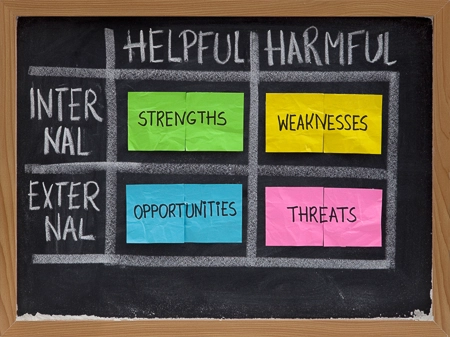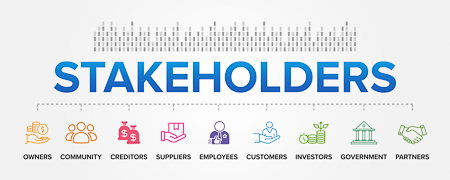Best Tools for Organisational Context Analysis in ISO 45001 Compliance
Top 5 Methods for ISO 45001 Organisational Context Analysis
Understanding organisational context is a critical requirement for ISO 45001 compliance. A well-structured organisational context analysis helps safety professionals design an effective safety management system (SMS).
This article explores the top 5 tools—SWOT, PESTLE, IPO, stakeholder mapping, and scenario planning—to conduct a thorough organisational context evaluation in line with ISO 45001 guidelines.
Like a master painter, a skilled management system designer has access to a range of tools, many of which have been well-researched and widely deployed across other areas of business management.
The choice of methods used at different stages of the analysis significantly impacts the results generated. Using the wrong tool yields the wrong results. Deploying the right tool at the wrong time produces inaccurate findings. Poor sequencing or improper integration of tools in relation to preceding and succeeding steps also leads to unreliable outcomes.
Here are the top five tools for analysing organisational context to comply with Section 4 of ISO 45001. These tools can be used together in whatever sequence best fits the intended analysis.
Organisations often operate within a complex landscape—ranging from existing systems and market position to ongoing projects. The selection of the next tool should be informed by these factors to ensure a meaningful and accurate assessment.
SWOT Analysis for Organisational Context in ISO 45001
SWOT analysis serves as a valuable mid-point analytical tool, while also being relevant at the early stages as an idea generator and at later stages as a confirmation of the analysis conducted.
It is one of the most widely recognised analytical tools, as many employees within an organisation may have encountered it in career planning, particularly during mentorship sessions or in preparation for performance reviews.
The Strengths and Weaknesses components of SWOT are often tied to internal factors—elements that the organisation has a clear understanding of and direct control over. Strengths analysis results in a list of attributes that the organisation is either inherently strong in or is situationally well-positioned to excel at. The key factor is that strengths are internal and largely within the organisation’s control.
For example, a major corporation that is already prequalified for government defense contracts has a level of built-in competence that, in itself, becomes a strength. This strength exists because the organisation has established subsystems that ensure compliance with strict regulations, reducing the risk of actions that could jeopardise its standing.
In practice, this means that the board and other key departments are likely to act swiftly on anything that may threaten the organisation’s reputation. In contrast, a smaller corporation primarily serving private clients—where alternative opportunities are plentiful— may not be as proactive in mitigating reputational risks, as its investment in regulatory compliance is lower.
This is a high-level approach to understanding strengths, and its application will vary for different organisations. A skilled systems designer must be able to identify the internal factors and subsystems that contribute to inherent or situational strengths. They must then tailor these insights to the organisation’s specific context with input from the brainstorming team.
During such stages, a tool like scenario planning can be briefly introduced to test the true nature of a perceived strength. This can then be supplemented or interwoven with a review of political, economic, social, technological, legal, and environmental (PESTLE) factors within the given scenario.
This highlights the fact that analysis tools serve as thinking paradigms, and a skilled management system designer can deploy them in a flexible manner, much like a master artist switching between brushes to achieve different effects.
Weaknesses form the other internal component of a SWOT analysis. For the purpose of SWOT, weaknesses are essentially the opposite of strengths—they highlight vulnerabilities that could undermine the organisation’s ability to manage risks effectively.
Using the previous example, a strength initially identified as valid may turn out to be a weakness when examined through a specific PESTLE lens in a particular scenario. This underscores the need to approach the analysis as an iterative problem-solving exercise, where results emerge dynamically rather than being fixed.
Opportunities are external factors that offer potential gains in areas where the company’s strengths can be leveraged or where its weaknesses can be mitigated. Opportunities represent growth areas. In practice, analysing opportunities follows a similar approach to strengths and weaknesses. Like strengths, opportunities can arise from both inherent and situational factors, and their availability may vary depending on the circumstances.

Threats constitute the second part of the external factors that may affect an organisation’s ability to manage the OH&S risks associated with its operations. They are largely the opposite of opportunities in terms of their potential impact. However, while opportunities tend to be beneficial but optional, threats can pose unavoidable risks and must be actively monitored.
A SWOT analysis, when used in combination with other tools as part of a comprehensive approach, is a compliant method for analysing organisational context under ISO 45001. Beyond compliance, however, it also serves as a valuable tool for building a safety management system that evolves to meet the growing needs of an organisation.
How PESTLE Analysis Helps in ISO 45001 Context Evaluation
A PESTLE analysis is an analytical tool used to identify external, globalised factors that could act as either headwinds or tailwinds for an organisation. In OH&S management systems, it helps to determine the external elements that may impact an organisation’s ability to achieve its goals.
PESTLE analysis focuses on broader market and environmental external factors, which, by their nature, have implications for the internal aspects of an organisation.
The COVID-19 pandemic is a strong example of a global external factor that affected organisations worldwide. Businesses with the best strategic planners would have accounted for potential pandemics under the political, economic, and social aspects of their PESTLE analysis while formulating strategies.
Similarly, the ongoing rise of AI is a technological innovation that will influence how organisations approach their OH&S objectives. While COVID-19 introduced significant headwinds for most organisations, it also created tailwinds for others, particularly in industries that saw an increase in demand during the crisis.
In the UK, the Grenfell Tower tragedy in 2017 deeply impacted national consciousness and inevitably led to legislative changes. The resulting fire safety regulation reforms would have been a key factor in the PESTLE analysis of all UK-based organisations in the construction industry.
A PESTLE analysis alone cannot provide a comprehensive understanding of an organisation’s context, but it serves as an important component of the analysis. It should always be used in conjunction with other analytical tools to ensure a well-rounded evaluation.
A culture of trust and care, like safety culture itself, is not willed into existence simply because a team desires it. It requires dedication, skill, and time to become embedded, and its benefits remain inaccessible until then.
Using IPO Analysis for ISO 45001 Risk Assessment
IPO analysis, is one of the simplest analytical tools in terms of its core structure. It is so straightforward that it almost eliminates the need for other methods. However, perhaps due to its simplicity, variations of the IPO model exist that incorporate additional elements while retaining its fundamental tripartite structure—Input, Process, and Output.
Like other analysis tools already highlighted, IPO analysis serves as a thinking framework that helps clarify and structure thoughts around an issue. In this case, it assists in understanding how an organisation can meet its OH&S goals while considering its organisational context.
In practice, IPO is one of the easiest tools to facilitate across an organisation, as it focuses on elements that workers are already familiar with: Input—what they need to perform their job; Process—how they execute their tasks; Output—their deliverables.
This tool is best used in conjunction with other analytical methods. It serves to complement and clarify findings from those tools, ensuring a more comprehensive understanding of the organisation’s operational context.
Stakeholder Mapping for Effective Safety Management in ISO 45001
A Stakeholder mapping analysis is similar to an IPO analysis and can be used to assess both the internal and external context of an organisation. However, while IPO focuses on operational phases—Input, Process, and Output—stakeholder analysis centres on the parties involved in operations and how their actions or inactions can impact the organisation’s ability to achieve its OH&S goals.
For a construction contracting company, key stakeholders include the entire supply chain on the input side, as well as the client, other subcontractors, its own subcontractors, regulators, training providers, auditors, and various other entities.

Gaining a thorough understanding of such an organisation’s context requires identifying how each stakeholder influences its ability to meet OH&S objectives. For example, if labour suppliers' manpower statistics are reported alongside those of the contractor as it usually is, then understanding the OH&S training and commitment levels of those suppliers becomes crucial. This factor could represent a significant threat to the contractor’s own OH&S performance, not to mention its duty of care to the workers assigned to its projects.
As with other analytical tools, stakeholder analysis is most effective when used in conjunction with complementary methods. The focus should be on achieving a holistic understanding of the organisation’s context rather than simply conducting a compliance-based, tick-box exercise.
Scenario Planning in ISO 45001: Preparing for Workplace Risks
In scenario planning, the analysis team examines a range of possible situations that an organisation may face and evaluates how it could still achieve its goals under those circumstances. This approach provides the management system designer with a comprehensive understanding of the organisation’s context by identifying which scenarios are likely, unlikely, or virtually impossible.
Given the vast range of potential scenarios an organisation may encounter, the system designer must carefully select scenarios that are not just possible, but also probable. The wide variation in potential scenarios explains why there are numerous approaches and adaptations of scenario planning. It is the most diverse of all the analysis tools listed above. As with other methods, scenario planning is most effective when used in conjunction with other analytical tools.

Ultimately, the focus of designing a safety management system should be on its objectives—objectives that can only be validated and achieved if the organisation's context is thoroughly understood.
The use of analysis tools for understanding the organisation’s context is an iterative process, allowing for the deployment of multiple tools to guide the analysis effectively.
A simplistic, single-tool approach to analysing an organisation’s context is likely to produce an oversimplified view, resulting in a management system that is inadequate for delivering on stated OH&S objectives.
All analysis tools serve as structured thinking aids designed to standardise how groups approach a particular topic. Their contents act as prompts or waypoints for identifying critical factors worthy of consideration. As such, these tools should be deployed holistically to guide collective thought in a comprehensive manner.
Frequently Asked Questions
Organisational context analysis is a key requirement in ISO 45001, ensuring that an occupational health and safety (OH&S) management system aligns with business objectives and regulatory requirements. It helps organisations:
- Identify internal and external factors that influence workplace safety.
- Understand market conditions, compliance obligations, and stakeholder expectations.
- Develop a tailored approach to managing OH&S risks effectively.
Without a structured organisational context analysis, safety management systems may fail to address key risks, leading to inefficiencies and non-compliance.
The most effective tools for organisational context analysis include:
- SWOT analysis – Evaluates strengths, weaknesses, opportunities, and threats in OH&S management.
- PESTLE analysis – Assesses political, economic, social, technological, legal, and environmental factors affecting safety performance.
- Stakeholder mapping – Identifies key stakeholders and their influence on OH&S policies.
- Risk-based thinking – Integrates proactive hazard identification and risk assessment into safety planning.
- Scenario planning – Models potential risks and evaluates response strategies.
Using a combination of these tools enhances organisational context analysis, improving the effectiveness of the OH&S management system.
SWOT analysis is an essential tool for assessing an organisation’s safety management effectiveness. It helps identify:
- Strengths – Internal capabilities that enhance workplace safety, such as strong leadership or advanced training.
- Weaknesses – Gaps in safety procedures, such as inadequate incident reporting or outdated equipment.
- Opportunities – External factors that can improve safety, such as technological advancements or regulatory changes.
- Threats – Risks that could compromise OH&S performance, such as budget cuts or skills shortages.
SWOT analysis should be used alongside tools like PESTLE to provide a comprehensive safety management approach.
Stakeholder analysis helps organisations understand the influence of various groups on OH&S performance. Key benefits include:
- Improving collaboration between employees, management, and regulatory bodies.
- Enhancing communication on safety initiatives.
- Identifying potential conflicts between safety goals and business objectives.
- Strengthening compliance with OH&S regulations.
A well-executed stakeholder analysis ensures an inclusive and balanced approach to workplace safety.
Scenario planning helps organisations anticipate and manage potential safety risks by modeling different future situations. Benefits include:
- Enhancing preparedness for emerging OH&S risks.
- Identifying weaknesses in existing safety strategies.
- Testing response procedures under different operational conditions.
- Ensuring flexibility in adapting to regulatory and industry changes.
When combined with SWOT and PESTLE, scenario planning strengthens risk management strategies for workplace safety.
This article examines the top tools for analysing organisational context in compliance with ISO 45001, their role in shaping an effective safety management system (SMS), and how to use them strategically to improve risk assessment and safety performance. For solutions that support data-driven safety analysis, stakeholder engagement, and compliance tracking, visit our Solutions Page and explore our integrated data analytics tools for safety management.